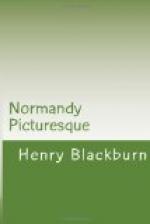Of the battle of Hastings itself, of the consternation at one time amongst the troops at the report of William’s death, of the charge of cavalry, with William on a tremendous black horse (riding as straight in the saddle as in our own day), of the cutting to pieces of the enemy, of the stripping the wounded on the ground, and of Harold’s defeat and death, there are several very spirited representations.
For our illustration we have chosen a scene where the battle is at its height, and the melee is given with great vigour. These figures on the tapestry are coloured green and yellow (for there was evidently not much choice of colours), and the chain armour is left white. The woodcut is about a third of the size, and is, as nearly as possible, a facsimile of the original.
[Illustration: Facsimile of Bayeux Tapestry.]
The last group is thus described in the catalogue:—
’ET FVGA VETERVNT ANGLI.
’Et les Anglais furent mis en fuite. Des hommes a pied, armes de haches et d’ipies, combattent contre les cavaliers: mais la defaite des Anglais est complete; ils sont poursuivis a toute outrance par les Normands vainqueurs.
’La scene suivante reprisentent des herauts d’armes a pied, et des cavaliers galoppant a toute bride pour annoncer probablement le succes du Conquerant; mais l’interruption subite du monument ne permet plus de continuer cette chronique figurie, qui allait vraisemblablement jusqu’au couronnement de Guillaume.
The design of the tapestry is very unequal, some of the latter scenes being weak in comparison, especially that of the death of Harold; the eleventh-century artist, perhaps becoming tired of the work, or having, more probably, a presentiment that this scene would be painted and exhibited annually, by English artists, to the end of time. Perhaps the most interesting and important scenes are:—first, when Harold takes the oath of allegiance to William, with his hands leaning on two ark-like shrines, full of the relics plundered from churches; next, the awful catastrophe of the malfosse, where men and horses, Norman and Saxon, are seen rolling together in the ditch; and, lastly, the ultra-grotesque tableaux of stripping the wounded after the battle.
The borders on the latter part of the tapestry (part of which we have shewn in the illustration) consist of incidents connected with the battle, and add greatly to its interest. Some of the earlier scenes are very amusing, having evidently been suggested by the fables of AEsop and Phaedrus; there are griffins, dragons, serpents, dogs, elephants, lions, birds, and monsters that suggest a knowledge of pre-Adamite life (some biting their own tails, or putting their heads into their neighbours’ mouths), interspersed with representations of ploughing, and hunting, and of killing birds with a sling and a stone.[22]




